The Green Blockchains of Circular Economy
Abstract
:1. Introduction
- An upgrade of the original CE-IoT blockchain with the principles of the HYPERLEGER project (https://www.hyperledger.org/, accessed on 23 July 2021) and its utilization by multiple actuator types;
- The incorporation of federated ML and the development of the “green-mining” concept;
- An extension of the main federated ML protocol and introduction of the “time-wise ML data offloading technique” that overcome the underlying obstacles, enhance confidentiality and privacy, and make the use of ML in blockchain cost-efficient.
2. Materials and Methods
Related Works—CE Studies, Trends, and Applications
3. Results—The CE-IoT Blockchain and Federated Learning
3.1. The Core CE-IoT Blockchain
3.1.1. Motivating Example
3.1.2. The Ledger
3.1.3. Actuators Roles
- The “Asset Registry Contract” is owned by the regulator and maintains the contract addresses for assets, operators, and auditors.
- The “Asset State Contract” is owned by the asset’s operator and contains the related LCA properties.
- The “Asset Audit Agreement Contract” is also owned by the operator and specifies the allowed actions for updating the Asset State Contract.
- The “List of Asset Agreements Contract” can be owned either by operators or auditors and contains the access agreements and their state (i.e., active or expired).
3.1.4. Implementation
- publishstream key1 ‘{“json”:{
- “component”:”C1, switch”,
- “location”:”CABLENET-room1”, “condition”:”maintenance”,
- “availability”:”working”}}’
3.2. Federated Learning with Green-Miners
3.2.1. DanKu Protocol
3.2.2. CE-IoT Extensions of the Pure DanKu Protocol
3.3. Evaluation of the Email Service and the Involved Equipment
3.4. Validation
4. Discussion and Future Work
4.1. Federated ML for CE
4.2. Future Work
5. Conclusions
Author Contributions
Funding
Conflicts of Interest
References
- Kalmykova, Y.; Sadagopan, M.; Rosado, L. Circular economy—From review of theories and practices to development of implementation tools. Resour. Conserv. Recycl. Sustain. Resour. Manag. Circ. Econ. 2018, 135, 190–201. [Google Scholar] [CrossRef]
- Heshmati, A. A review of the circular economy and its implementation. Int. J. Green Econ. 2018, 11, 251–288. [Google Scholar] [CrossRef] [Green Version]
- Urbinati, A.; Chiaroni, D.; Chiesa, V. Towards a new taxonomy of circular economy business models. J. Clean. Prod. 2017, 168, 487–498. [Google Scholar] [CrossRef]
- Issa, T.; Issa, T.; Issa, T. Awareness, Opportunities and Challenges of Green IT: An Australian Perspective. In Sustainability Awareness and Green Information Technologies, Green Energy and Technology; Springer: Cham, Switzerland, 2020; pp. 443–462. [Google Scholar]
- Bigliardi, B.; Filippelli, S. Investigating Circular Business Model Innovation through Keywords Analysis. Sustainability 2021, 13, 5036. [Google Scholar] [CrossRef]
- Askoxylakis, I. A framework for pairing circular economy and the Internet of Things. In Proceedings of the IEEE International Conference on Communications (ICC), Kansas City, MO, USA, 20–24 May 2018. [Google Scholar]
- Galati, F.; Bigliardi, B. Industry 4.0: Emerging themes and future research avenues using a text mining approach. Comput. Ind. 2019, 109, 100–113. [Google Scholar] [CrossRef]
- Buterin, V. A Next-Generation Smart Contract and Decentralized Application Platform. GitHub White Paper. , 2014. Available online: https://github.com/ethereum/wiki/wiki/White-Paper (accessed on 23 July 2021).
- Hamdaoui, B.; Zorba, N.; Rayes, A. Participatory IoT Networks-on-Demand for Safe, Reliable and Responsive Urban Cities. IEEE Blockchain Technical Briefs. January 2019. Available online: https://blockchain.ieee.org/technicalbriefs/january-2019/participatory-iot-networks-on-demand-for-safe-reliable-and-responsive-urban-cities?highlight=WyJidXNpbmVzcyIsImxhdyJd (accessed on 23 July 2021).
- Xu, X. A taxonomy of blockchain-based systems for architecture design. In Proceedings of the 2017 IEEE International Conference on Software Architecture (ICSA), Gothenburg, Sweden, 3–7 April 2017; pp. 243–252. [Google Scholar]
- Larrucea, X.; O’Connor, R.V.; Colomo-Palacios, R.; Laporte, C.Y. Software process improvement in very small organizations. IEEE Softw. 2016, 33, 85–89. [Google Scholar] [CrossRef] [Green Version]
- Alanazi, S.; Dabbagh, M.; Hamdaoui, B.; Guizani, M.; Zorba, N. Reducing data center energy consumption through peak shaving and locked-in energy avoidance. IEEE Trans. Green Commun. Netw. 2017, 1, 551–562. [Google Scholar] [CrossRef]
- Yang, Y.; Zheng, Z.; Bian, K.; Song, L.; Han, Z. Sensor Deployment Recommendation for 3D Fine-Grained Air Quality Monitoring Using Semi-Supervised Learning; IEEE ICC: Kansas City, MO, USA, 2018; pp. 1–6. [Google Scholar]
- Datsika, E.; Antonopoulos, A.; Passas, N.; Kormentzas, G.; Verikoukis, C. Green Resource Management for Over-the-Top Services in 5G Networks Using Matching Theory; IEEE ICC: Kansas City, MO, USA, 2018; pp. 1–6. [Google Scholar]
- Issa, T.; Issa, T.; Issa, T.B.; Isaias, P. Sustainability Awareness and Green Information Technologies; Green Energy and Technology; Springer: Berlin/Heidelberg, Germany, 2020; pp. 1–554. [Google Scholar]
- Hatzivasilis, G.; Papaefstathiou, I.; Plexousakis, D.; Manifavas, C.; Papadakis, N. AmbISPDM: Managing embedded systems in ambient environment and disaster mitigation planning. Appl. Intell. 2017, 48, 1623–1643. [Google Scholar] [CrossRef]
- Alexandris, G.; Katos, V.; Alexaki, S.; Hatzivasilis, G. Blockchains as enablers for auditing cooperative circular economy networks. In Proceedings of the 2018 IEEE 23rd International Workshop on Computer Aided Modeling and Design of Communication Links and Networks (CAMAD), Barcelona, Spain, 17 September 2018; pp. 1–7. [Google Scholar]
- Camacho-Otero, J.; Boks, C.; Pattersen, I.N. Consumption in the circular economy: A literature review. Sustainability 2018, 10, 2758. [Google Scholar] [CrossRef] [Green Version]
- Moraga, G.; Huysveld, S.; Mathieux, F.; Blengini, G.A.; Alaerts, L.; Van Acker, K.; de Meester, S.; Dewulf, J. Circular economy indicators: What do they measure? Resour. Conserv. Recycl. 2019, 146, 452–461. [Google Scholar] [CrossRef] [PubMed]
- Pagoropoulos, A.; Pigosso, D.C.; McAloone, T.C. The emergent role of digital technologies in the Circular Economy: A review. Proc. CIRP 2017, 64, 19–24. [Google Scholar] [CrossRef] [Green Version]
- Khalamayzer, A. 7 Companies Advancing the Circular Economy by Selling Products as a Service. GreenBiz, February 2018. Available online: https://www.greenbiz.com/article/7-companies-advancing-circular-economy-selling-products-service (accessed on 23 July 2021).
- Okorie, O.; Salonitis, K.; Charnley, F.; Moreno, M.; Turner, C.; Tiwari, A. Data-driven approaches for circular economy in manufacturing for digital technologies: A review of current research and proposed framework. Preprints 2018, 2018080159. [Google Scholar] [CrossRef]
- Lin, K.-Y. User experience-based product design for smart production to empower industry 4.0 in the glass recycling circular economy. Comput. Ind. Eng. 2018, 125, 729–738. [Google Scholar] [CrossRef]
- Lieder, M.; Asif, F.M.A.; Rashid, A. Towards circular economy implementation: An agent-based simulation approach for business model changes. Auton. Agents Multi-Agent Syst. 2017, 31, 1377–1402. [Google Scholar] [CrossRef] [Green Version]
- Despeisse, M.; Baumers, M.; Brown, P.; Charnley, F.; Ford, S.; Garmulewicz, A.; Knowles, S.; Minshall, T.; Mortara, L.; Reed-Tsochas, F.; et al. Unlocking value for a circular economy through 3D printing: A research agenda. Technol. Forecast. Soc. Change 2017, 115, 75–84. [Google Scholar] [CrossRef] [Green Version]
- Williams, E.; Hatanaka, T. Residential computer usage patterns in Japan and associated life cycle energy use. In Proceedings of the 2005 IEEE International Symposium on Electronics and the Environment, New Orleans, LA, USA, 16–19 May 2005; pp. 177–182. [Google Scholar]
- Bag, S.; Yadav, G.; Wood, L.C.; Dhamija, P.; Joshi, S. Industry 4.0 and the circular economy: Resource melioration in logistics. Resour. Policy 2020, 68, 1–16. [Google Scholar] [CrossRef]
- Bag, S.; Gupta, S.; Foropon, C. Examining the role of dynamic remanufacturing capability on supply chain resilience in circular economy. Manag. Decis. 2019, 57, 863–885. [Google Scholar] [CrossRef]
- Giudice, M.D. Supply chain management in the era of circular economy: The moderating effect of big data. Int. J. Logist. Manag. 2021, 32, 337–356. [Google Scholar] [CrossRef]
- Bag, S.; Wood, L.C.; Xu, L.; Dhamija, P.; Kayikci, Y. Big data analytics as an operational excellence approach to enhance sustainable supply chain performance. Resour. Conserv. Recycl. 2020, 153, 1–10. [Google Scholar] [CrossRef]
- Dubey, R.; Gunasekaran, A.; Childe, S.J.; Blome, C.; Papadopoulos, T. Big data and predictive analytics and manufacturing performance: Integrating institutional theory, resource-based view and big data culture. Br. J. Manag. 2019, 30, 341–361. [Google Scholar] [CrossRef]
- Upadhyay, A.; Mukhuty, S.; Kumar, V.; Kazancoglu, Y. Blockchain technology and the circular economy: Implications for sustainability and social responsibility. J. Clean. Prod. 2021, 293, 1–7. [Google Scholar] [CrossRef]
- Yildizbasi, A. Blockchain and renewable energy: Integration challenges in circular economy era. Renew. Energy 2021, 176, 183–197. [Google Scholar] [CrossRef]
- Stankovic, M.; Gupta, R.F.J.I. Industry 4.0—Opportunities behind the challenge. United Nations Industrial Development Organization (UNIDO). In Proceedings of the Background Paper for UNIDO General Conference, Abu Dhabi, United Arab Emirates, 17 November–1 December 2017; pp. 1–32. [Google Scholar]
- Geng, Y.; Sarkis, J.; Bleischwitz, R. How to globalize the circular economy. Nat. Comment 2019, 565, 153–155. [Google Scholar] [CrossRef] [PubMed] [Green Version]
- State of Green. Circular Consumption through Innovative Business Models. November 2017. Available online: https://stateofgreen.com/en/partners/state-of-green/news/circular-consumption-through-innovative-business-models/ (accessed on 23 July 2021).
- Lyndegaard, K. Combining spatial and network analysis: A case study of the GoMore network. In Proceedings of the ESRI European User Conference (EUC), Split, Croatia, 13–15 October 2014; pp. 1–11. [Google Scholar]
- Slimane, K.B.; Chaney, D. Towards marketing of functionality: Insights from Michelin and Hilti. J. Strateg. Mark. 2015, 23, 224–237. [Google Scholar] [CrossRef]
- Worth, A.T.S.; Escartin-Claveria, B. Alstom’s approach to railway condition monitoring. In Proceedings of the 6th IET Conference on Railway Condition Monitoring (RCM), Birmingham, UK, 17–18 September 2014; pp. 1–6. [Google Scholar]
- Orehek, M.; Robl, C. Model-based design of an ECU with data- and event-driven parts using auto code generation. In Proceedings of the IEEE ICRA, Seoul, Korea, 21–26 May 2001; pp. 1346–1351. [Google Scholar]
- Persis, D.J.; Venkatesh, V.G.; Sreedharan, V.R.; Shi, Y.; Sankaranarayanan, B. Modelling and analysis the impact of circular economy; Internet of Things and ethical business practices in the VUCA world: Evidence from the food processing industry. J. Clean. Prod. 2021, 301, 1–13. [Google Scholar]
- Maksimovic, M.; Vujovic, V.; Omanovic-Miklicanin, E. Application of Internet of Things in food packaging and transportation. Int. J. Sustain. Agric. Manag. Inform. IJSAMI 2015, 1, 333–350. [Google Scholar] [CrossRef]
- Bouzembrak, Y.; Kluche, M.; Gavai, A.; Marvin, H.J.P. Internet of Things in food safety: Literature review and a bibliometric analysis. Trends Food Sci. Technol. 2019, 94, 54–64. [Google Scholar] [CrossRef]
- Kodan, R.; Parmar, P.; Pathania, S. Internet of Things for food sector: Status quo and projected potential. Food Rev. Int. 2020, 36, 584–600. [Google Scholar] [CrossRef]
- Kazancoglu, Y.; Ekinci, E.; Mangla, S.K.; Sezer, M.D.; Kayikci, Y. Performance evaluation of reverse logistics in food supply chains in a circular economy using system dynamics. Bus. Strategy Environ. 2021, 30, 71–91. [Google Scholar] [CrossRef]
- Heitlinger, S.; Bryan-Kinns, N.; Comber, R. Connected seeds and sensors: Co-designing Internet of Things for sustainable smart cities with urban food-growing communities. In Proceedings of the 15th Participatory Design Conference, Hasselt, Belgium, 20–24 August 2018; pp. 1–8. [Google Scholar]
- Arora, N.; Kaur, P.D. Augmenting banking and FinTech with intelligent Internet of Things Technology. In Proceedings of the 8th International Conference on Reliability, Infocom Technologies and Optimization (Trends and Future Directions) (ICRITO), Noida, India, 4–5 June 2020; pp. 648–653. [Google Scholar]
- Ramalingam, H.; Venkatesan, V.P. Conceptual analysis of Internet of Things use cases in banking domain. In Proceedings of the 2019 IEEE Region 10 Conference (TENCON), Kochi, India, 17–20 October 2019; pp. 2034–2039. [Google Scholar]
- Dewick, P.; Bengtsson, M.; Cohen, M.J.; Sarkis, J.; Schroder, P. Circular economy finance. J. Ind. Ecol. 2020, 24, 1192–1200. [Google Scholar] [CrossRef]
- Ozili, P.K.; Opene, F. The role of banks in the circular economy. World J. Sci. Technol. Sustain. Dev. 2021, 1–9. [Google Scholar] [CrossRef]
- Ozili, P.K. Circular economy, banks and other financial institutions: What’s in it for them? Circ. Econ. Sustain. J. 2021, 1, 1–18. [Google Scholar]
- Ellen MacArthur Foundation. Achieving “Growth Within”: A €320-Billion Circular Economy Investment Opportunity Available to Europe up to 2025. London, UK. 2017. Available online: https://www.ellenmacarthurfoundation.org/assets/downloads/publications/Achieving-Growth-Within-20-01-17.pdf (accessed on 2 August 2021).
- FinanCE Working Group. Circular Economy Finance Guidelines. Amsterdam, The Netherlands. 2018. Available online: https://www.ing.com/Newsroom/News/ABN-AMRO-ING-and-Rabobank-launch-finance-guidelines-for-circular-economy.htm (accessed on 2 August 2021).
- Geissdoerfer, M.; Savaget, P.; Bocken, N.; Hultink, E. The circular economy: A new sustainability paradigm? J. Clean. Prod. 2017, 143, 757–768. [Google Scholar] [CrossRef] [Green Version]
- Dapp, M.M. Towards a sustainable circular economy powered by community-based incentive systems. In Business Transformation through Blockchain, 1st ed.; Palgrave Macmillan, H., Beck, R., Eds.; Palgrave Macmillan: Cham, Switzerland, 2019; pp. 153–181. [Google Scholar]
- Wang, B.; Farooque, M.; Zhong, R.Y.; Zhang, A.; Liu, Y. Internet of Things (IoT)-Enabled accountability in source separation of household waste for a circular economy in China. J. Clean. Prod. 2021, 300, 1–47. [Google Scholar] [CrossRef]
- Gligoric, N. Smarttags: IoT product passport for circular economy based on printed sensors and unique item-level identifiers. Sensors 2019, 19, 586. [Google Scholar] [CrossRef] [PubMed] [Green Version]
- Dannen, C. Introducing Ethereum and Solidity: Foundation of Cryptocurrency and Blockchain Progamming for Beginners; Apress: New York, NY, USA, 2017; pp. 1–185. [Google Scholar]
- Pezoa, F.; Reutter, J.L.; Suarez, F.; Ugarte, M.; Vrgoč, D. Foundations of JSON schema. In Proceedings of the International World Wide Web Conference Committee (IWeC2), ACM, Montreal, QC, Canada, 11–15 April 2016; pp. 263–273. [Google Scholar]
- Bellifemine, F. JADE: A software framework for developing multi-agent applications. Lessons learned. Inf. Softw. Technol. 2008, 50, 10–21. [Google Scholar] [CrossRef]
- Kurtulmus, A.B.; Daniel, K. Trustless machine learning contracts; Evaluating and exchanging machine learning models on the Ethereum blockchain. In Proceedings of the Artificial Intelligence Conference, San Francisco, CA, USA, 5–7 September 2018; pp. 1–11. [Google Scholar]
- Murthy, S.; Bakar, A.A.; Rahim, F.A.; Ramli, R. A comparative study of data anonymization techniques. In Proceedings of the 2019 IEEE 5th International Conference on Big Data Security on Cloud (BigDataSecurity), IEEE International Conference on High Performance and Smart Computing (HPSC) and IEEE International Conference on Intelligent Data and Security (IDS), Washington, DC, USA, 27–29 May 2019; pp. 306–309. [Google Scholar]
- Rayana, S.; Akoglu, L. Less Is More: Building Selective Anomaly Ensemble. ACM TKDD 2016, 10, 1–33. [Google Scholar] [CrossRef]
- Berg, M.R.; Bakker, C.A. A product design framework for a circular economy. In Proceedings of the Product Lifetime and the Environment (PLATE) Conference, Nottingham, UK, 17–19 June 2015; pp. 365–379. [Google Scholar]
- News 18. Elon Musk Mocks Anonymous’ Cryptocurrency Threat with a ‘Hannah Montana’ Meme. 14 June 2021. Available online: https://www.news18.com/news/buzz/elon-musk-mocks-anonymous-cryptocurrency-threat-with-a-hannah-montana-meme-3844637.html (accessed on 23 July 2021).
- Charnley, F.; Tiwari, D.; Hutabarat, W.; Moreno, M.; Okorie, O.; Tiwari, A. Simulation to Enable a Data-Driven Circular Economy. Sustainability 2019, 11, 3379. [Google Scholar] [CrossRef] [Green Version]
- Godsiff, P.; Wood, Z. Circular insurance: Customer-centric, data-driven services for the circular economy. In Proceedings of the 54th Hawaii International Conference on System Sciences (HICSS), Waikoloa Village, HI, USA, 5 January 2021; pp. 1686–1695. [Google Scholar]
- Hatzivasilis, G.; Chatziadam, P.; Petroulakis, N.; Ioannidis, S.; Mangini, M.; Kloukinas, C.; Yautsiukhin, A.; Antoniou, M.; Katehakis, D.G.; Panayiotou, M. Cyber insurance of information systems. In Proceedings of the 24th IEEE International Workshop on Computer Aided Modeling and Design of Communication Links and Networks (CAMAD 2019), Limassol, Cyprus, 11–13 September 2019; pp. 1–7. [Google Scholar]
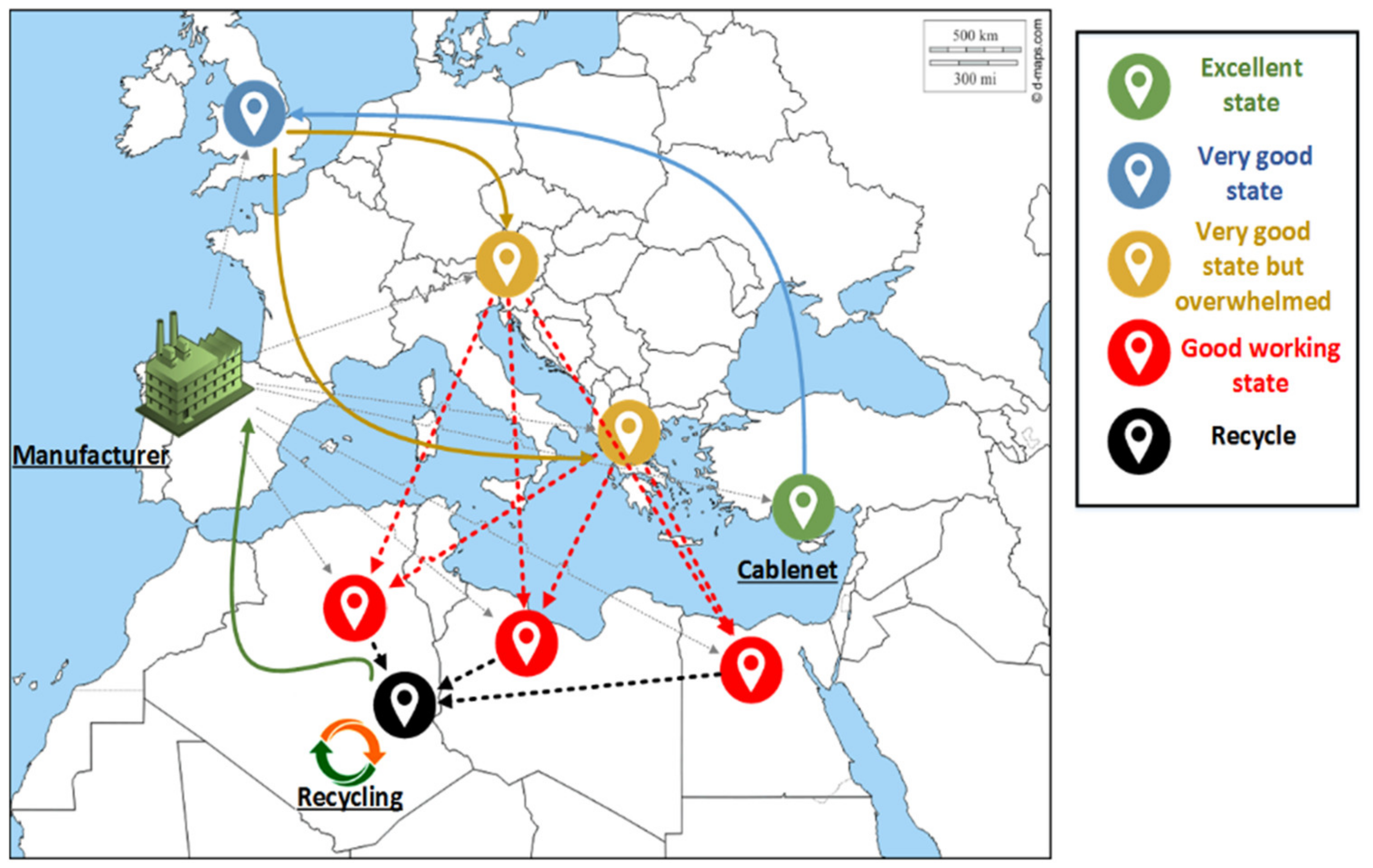
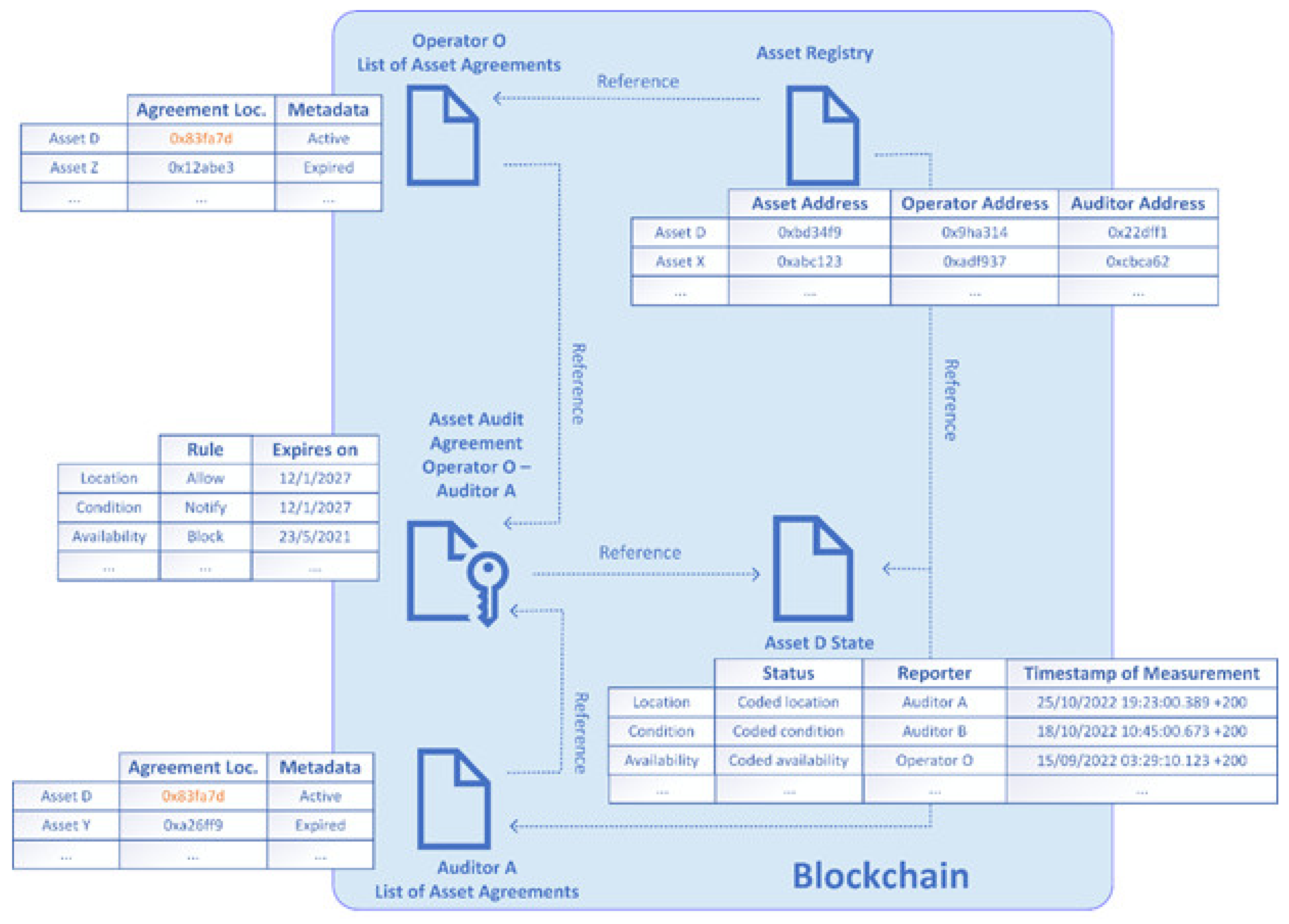

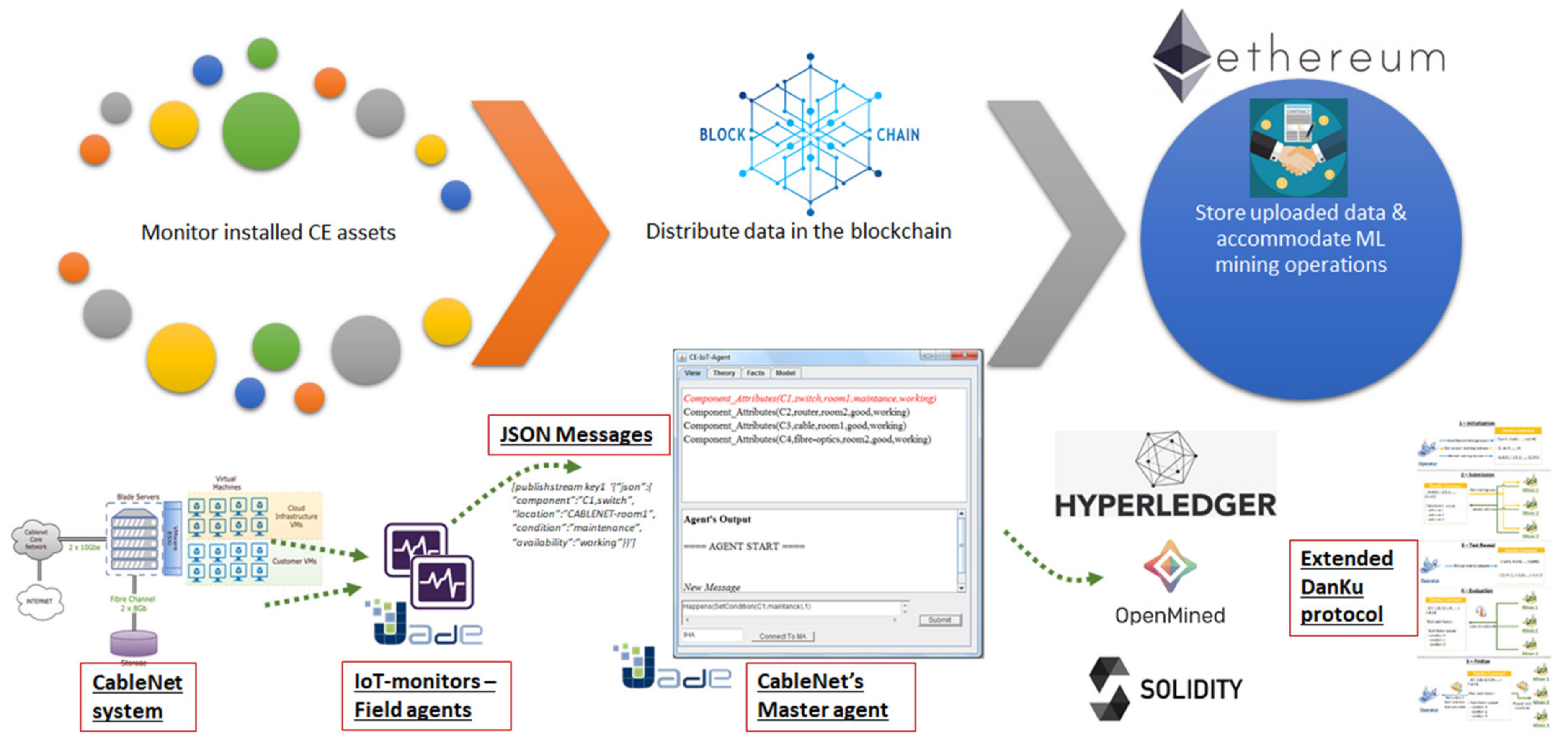
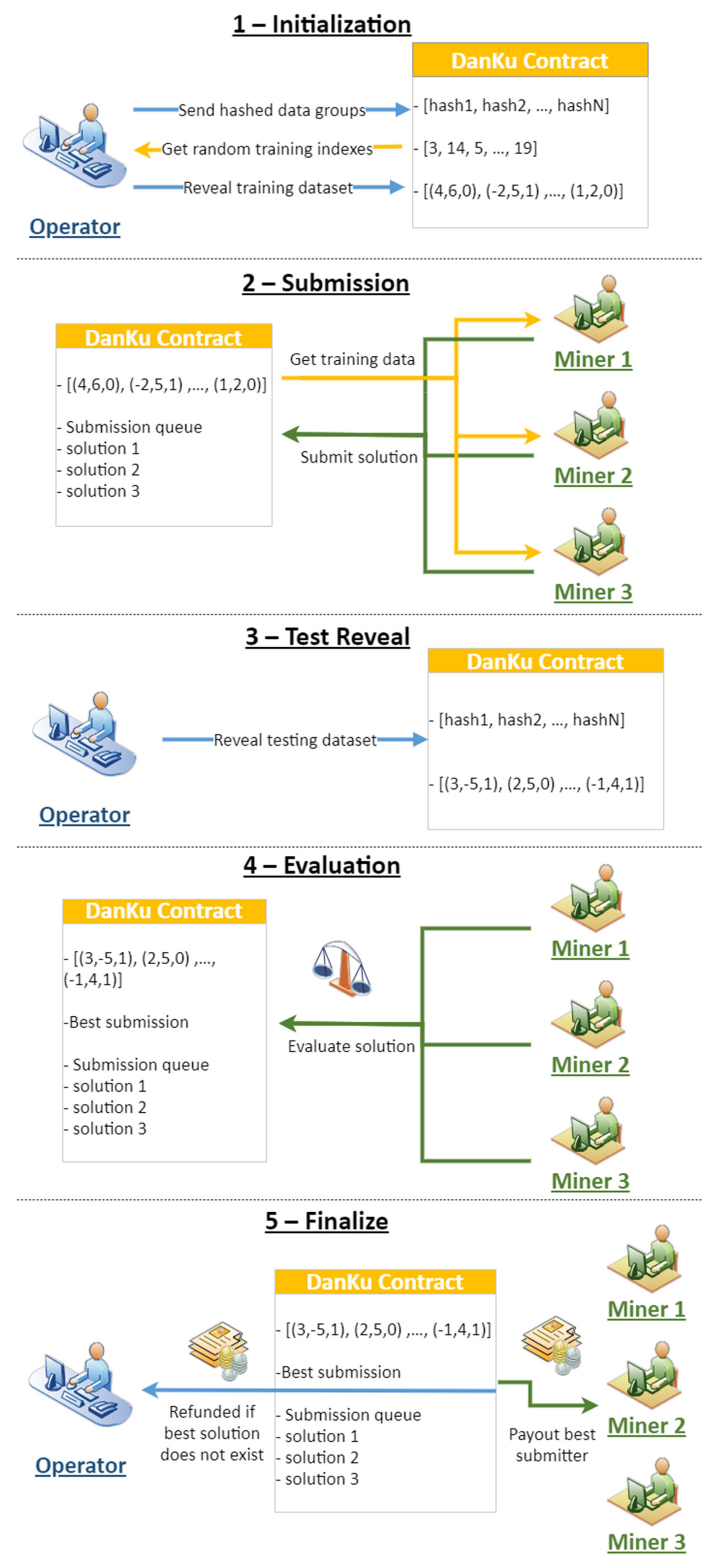
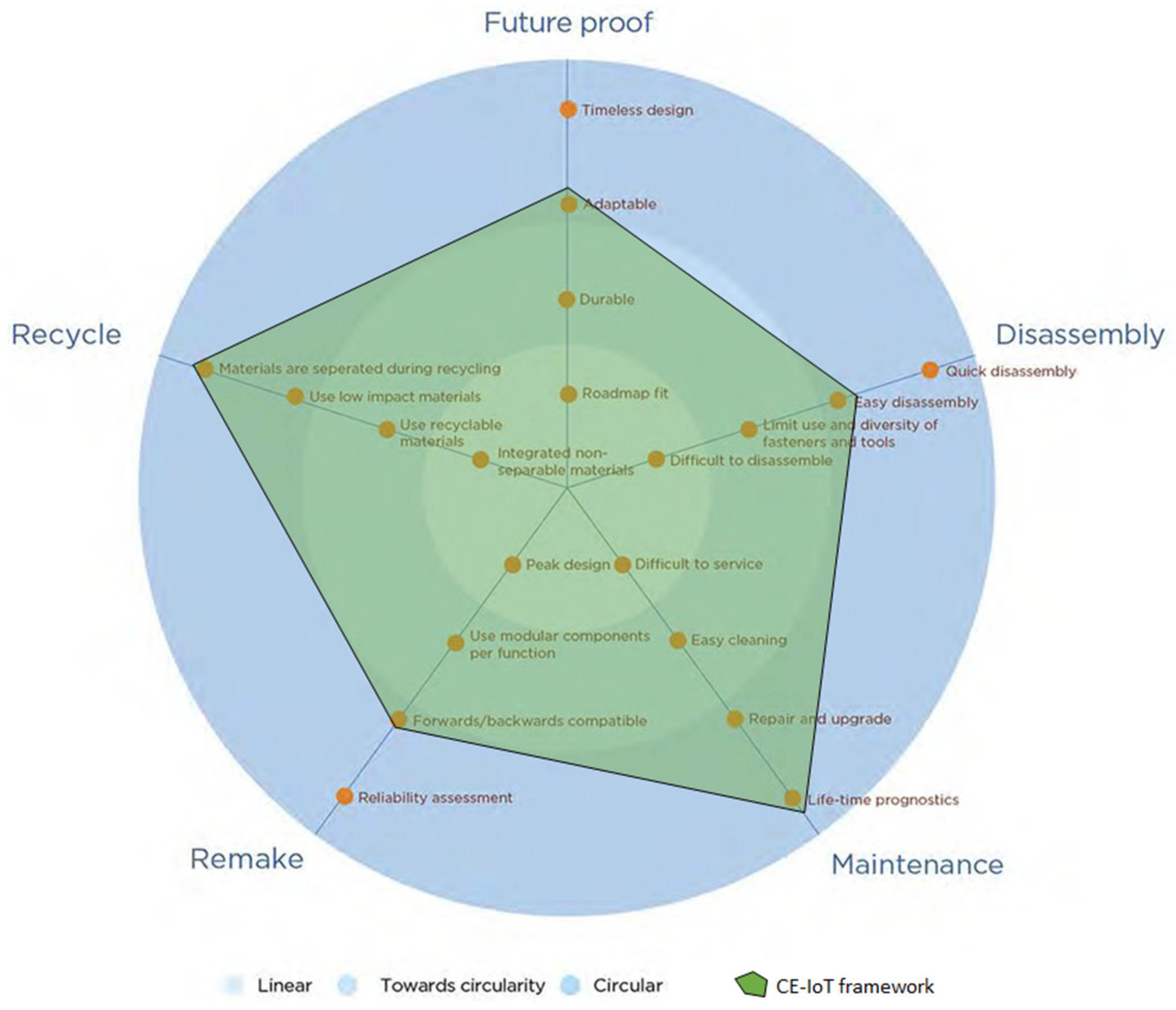
Publisher’s Note: MDPI stays neutral with regard to jurisdictional claims in published maps and institutional affiliations. |
© 2021 by the authors. Licensee MDPI, Basel, Switzerland. This article is an open access article distributed under the terms and conditions of the Creative Commons Attribution (CC BY) license (https://creativecommons.org/licenses/by/4.0/).
Share and Cite
Hatzivasilis, G.; Ioannidis, S.; Fysarakis, K.; Spanoudakis, G.; Papadakis, N. The Green Blockchains of Circular Economy. Electronics 2021, 10, 2008. https://doi.org/10.3390/electronics10162008
Hatzivasilis G, Ioannidis S, Fysarakis K, Spanoudakis G, Papadakis N. The Green Blockchains of Circular Economy. Electronics. 2021; 10(16):2008. https://doi.org/10.3390/electronics10162008
Chicago/Turabian StyleHatzivasilis, George, Sotiris Ioannidis, Konstantinos Fysarakis, George Spanoudakis, and Nikos Papadakis. 2021. "The Green Blockchains of Circular Economy" Electronics 10, no. 16: 2008. https://doi.org/10.3390/electronics10162008
APA StyleHatzivasilis, G., Ioannidis, S., Fysarakis, K., Spanoudakis, G., & Papadakis, N. (2021). The Green Blockchains of Circular Economy. Electronics, 10(16), 2008. https://doi.org/10.3390/electronics10162008









